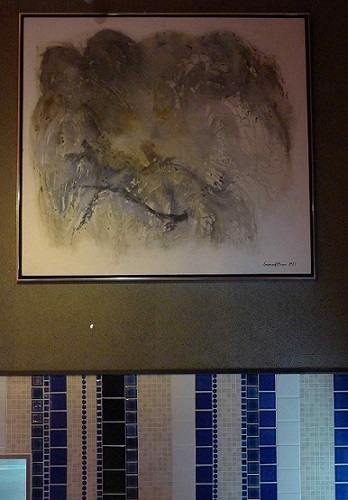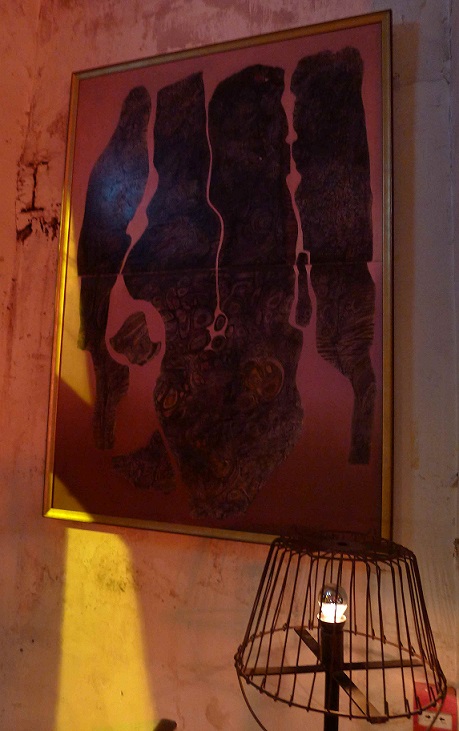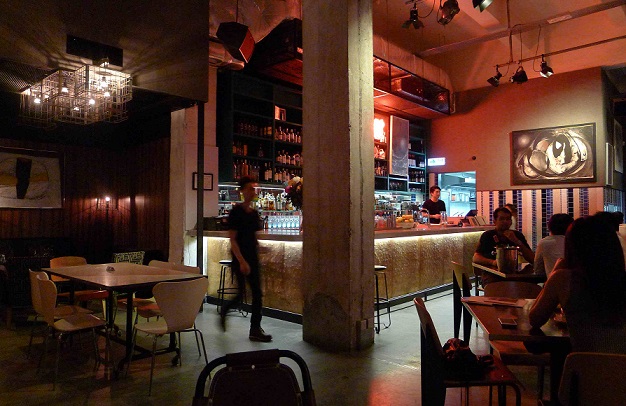Reviews & Articles
A Pill to Calm Me Down: Hong Kong in the 1970s
John BATTEN
at 6:26pm on 16th May 2016





Captions:
1. Rosamond Brown, Chinese Blue Jays, acrylic on canvas, 114x114cm, 1977
2. Douglas Bland, Reflection 9, acrylic on canvas, 95x135cm, circa 1970s
3. Gaylord Chan, Untitled, acrylic on canvas, 120x90cm, circa 1970s
4. Luis Chan, Landscape with Sailboats & Figure, ink and colour on paper, 134x68.5cm, 1974
5. Irene Chou, Ode to Joy, ink on paper, 117.5x162cm, undated (circa 1970s)
All photos: John Batten, inside Ping Pong Gintoneria, Sai Ying Pun
(原文以英文發表,評論西營盤乒乓冰室舉辦之〈Hanging Out香港70年代藝術展〉 (29.3. – 15.5.2016) 。)
The Australian rock band Skyhooks have no connection with Hong Kong but their 1974 record Living in the 70’s has a topical title and such songs as ‘You Just Like Me ‘Cos I’m Good In Bed’, ‘Whatever Happened to the Revolution?’, ‘Horror Movie’ and ‘Motorcycle Bitch’ give a flavour of the time and music’s decade-evolving move from folk/country/rock to punk. The lyrics of the album’s title song describe a bad 70s dream: “I’m living in the 70’s / Eating fake food under plastic trees / My face gets dirty just walkin’ around / I need another pill to calm me down / I feel a bit nervous / I feel a bit mad / I feel like a good time that’s not been had / I feel a bit fragile / I feel a bit low / Like I learned the right lines / But I’m on the wrong show….” The 1970s were hedonistic and an “overdose” then was just a misadventure rather than a serious encounter with drugs. In attitude, it was a confusing, evolving period between the “generation gap” of World War II and Depression-era parents and teenagers experiencing the overhang from the previous decade, the ‘dreamy’ sixties.
Hong Kong was caught in some of that ‘overhang.’ In the early years of the decade the Vietnam War’s destruction continued (but its aftermath would continue for decades with boatloads of refugees arriving in Hong Kong) and China’s Cultural Revolution and its “struggle sessions” murderously justified retribution between the classes and China’s competing political factions. Meanwhile, Hong Kong was an active and important interface for Cold War posturing. It was a highly militarized place, with countless docks, barracks, airfields, and spy-listening facilities scattered around the ‘territory’ – all now, ironically, occupied by the People’s Liberation Army. Naval cruisers, destroyers and aircraft carriers of the Western powers regularly pulled into Victoria Harbour for refueling or sometime wild periods of R-and-R. Few vestiges of that time now survive: Tsim Sha Tsui’s Red Lips bar is in name only, but Ned Kelly’s Last Stand nightly still plays traditional jazz in its original 1870s-style/retro-1970s ambience. Hong Kong’s Foreign Correspondents’ Club has a room of war photographs and the China Fleet Club in Wan Chai continues to offer advice to visiting servicemen and kindly makes available a dedicated letter-box for mail to be directly sent stateside (to the USA).
While worldly issues were reported by Hong Kong-based China-watchers, often through the excellent weekly Far Eastern Economic Review, most people living in Hong Kong were just happy to eke out a living. The British touch-base policy, in operation until 1980, allowed immigrants from China arriving in Hong Kong and who reached the urban areas to apply for residency. A continuing influx of immigrants - mainly young men - offered cheap labour, fueling Hong Kong’s legendary entrepreneurial spirit and manufacturing industries. Hong Kong’s famed trading and shopping status was cemented in the early 1970s with the start of low-cost mass airline travel. But, housing was very tight and at the end of the decade over 700,000 people still lived in crowded, makeshift squatter areas.
Hong Kong has always been a place of split communities – between Western and Chinese; rich and poor; English and Chinese languages; educated and uneducated; public and private housing. However, it was in the 1970s that saw fundamental changes in colonial government policies towards its responsibilities in Hong Kong. Its culmination was the Sino-British Joint Declaration of 1984 to return Hong Kong to China in 1997.
Art and culture in Hong Kong had never received much formal support from British colonial administrators, but after the agitation of the Cultural Revolution had spilled into Hong Kong and incited the 1967 riots, the government instituted a range of community contact points, facilities and activities. The first Hong Kong Festivals in the 1970s were the forerunner of the current Hong Kong Art Festival. Plans for a large cultural centre in Tsim Sha Tsui, comprising performing arts venues and a larger museum were formulated to give greater space than the Hong Kong Museum of Art’s Central City Hall. In 1973, The Chinese University of Hong Kong (CUHK) moved to its present Shatin campus, while the Confucian-liberal-arts New Asia College – one of the constituent colleges of the university - saw in the late 1960s its first graduates from its fine arts course.
Hong Kong’s artists, those inspired by modernism rather than traditional ink painting, received art training from a variety of sources: prominent were teachers’ training colleges and the Extramural Studies Department of CUHK; and, for Luis Chan, tuition was previously done by correspondence from London. Exhibitions were often self-organised or through artist groups, such as the Hong Kong Art Society, and held in informal exhibition venues including Li Hall of St John’s Cathedral. John Warner, the first Chief Curator of the Hong Kong Museum of Art was supportive and often opened the Museum’s galleries to group exhibitions.
Hong Kong’s art scene was small, but a mixture of enthusiastic foreign and local artists saw a fluid interaction. Trained artists Kitty Burns and Rosamond Brown happily mixed across the social divide and regularly debated art issues with Hon Chi-fun. The Taiwanese-trained Cheung Yee was highly influential on a young Ha Bik-chuen, whose style was highly imitative of Cheung Yee. The graphic artist Arthur Hacker brought a strong design-sense direct from then-swinging London and a subversive sensibility (as in his Lap Sap Chung litterbug cartoon character) has influenced a generation of fellow-designers. Douglas Bland, whose work is ripe for reassessment, bravely combined Western and Chinese ink painting techniques and composition in his painting. Yau Leung is known for his black-and-white photographs of Hong Kong’s older urban areas, but also did commercial colour photography assignments.

Antonio Mak, Standing Figure 1, bronze (framed), 12.5x4.3cm, 1977.
Fantasy has a special place in this period. The sculptor Antonio Mak juxtaposes various incongruous elements, lions and ladders with people. Gerard Henderson’s paintings can best be seen in the Mandarin Hotel’s Grill Room – commissioned pieces darkly evocative of bacchanalian scenes of the good life. The amorphous, humanoid shapes of Gaylord Chan and the beautiful otherworld and childhood reminiscences of Chu Hing-wah both set a bar that they would dynamically explore in future years. Kwok Mang-ho, Hong Kong’s inimitable Frog King, experimented with different media in the 1970s and an example of his use of car tyres as sculpture is on permanent display in an obscure location in the lobby of City Hall. Irene Chou, with Lou Shou-kwan, bridged the boundaries of Chinese gestural ink painting into Western abstraction.
Luis Chan is the star of this period, and one of the most remarkable artists of Greater China. From being overtly conventional in the 1950s, he undertakes a complete reversal of style after seeing contemporary art exhibitions and encountering Pop art and design in the 1960s. Chan depicts Hong Kong in a sea-bound landscape with mountains and clouds comprising a fantastical array of people and animals. He is a unique artist that captures Hong Kong as an evolving historic landscape – it is tempting to think how he would now depict Hong Kong’s sky-high skyline.
Ping Pong’s exhibition of 1970s Hong Kong art is a taster of what was happening by some of the active artists in this decade. It is also a timely reminder of the origins of Hong Kong’s current contemporary art scene – and of the city’s quiet inner strength, achieved despite and alongside its own singular energy.
Artists featured in Hanging Out:
Douglas BLAND
Rosamond BROWN
Kitty BURNS
Antonio CASADEI
Gaylord CHAN
Luis CHAN Ha Tien
CHEUNG Yee
Irene CHOU Lu Yun
DING Yanyong
Arthur HACKER
HON Chi Fun
KWOK Mang Ho
LIU Kuo-sung
Antonio MAK
MENG Minsheng
Gladys PALMER
Brian TILBROOK
YAU Leung
Jackson YU Shaozeng
TSANG Tsou-choi
This catalogue essay was published to accompany Hanging Out-an exhibition of Hong Kong art of the 70s in the bar setting of Ping Pong, Sai Ying Pun, Hong Kong - 29 March to 15 May 2016.
原文刊登於〈Hanging Out香港70年代藝術展〉展覽場刊。
